A few readers have recently asked me:
“What are your plans, music-wise, for your new baby girl as she grows up?”
This blog post will answer that question!
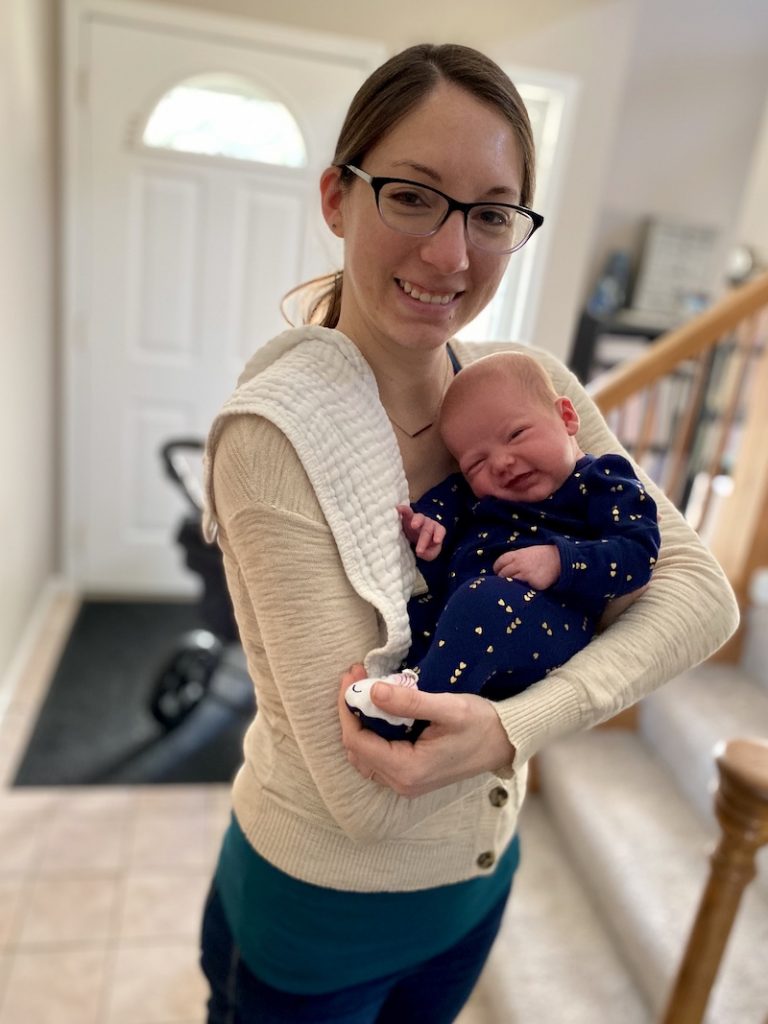
A few readers have recently asked me:
“What are your plans, music-wise, for your new baby girl as she grows up?”
This blog post will answer that question!

Hello, friends! I have two things to share with you.
I want to say THANK YOU for the many congrats and well-wishes I received from you upon the announcement of our new baby girl, Aria. My husband and I have been waiting a long time for our precious bundle. We feel so blessed to have her in our lives — as well as such a supportive community of friends and family. It was so nice to receive so many kind comments and personal emails from you!
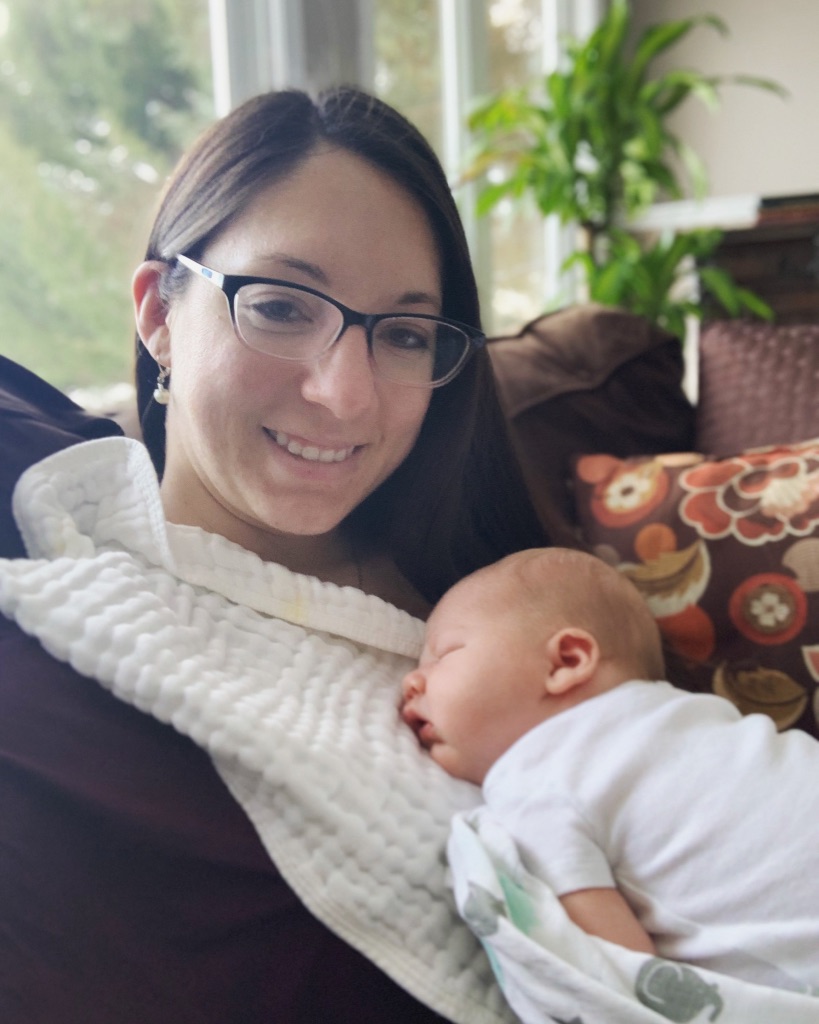
A few of you were curious about what I am doing / plan to do music-wise with Aria. I’ll answer this question in a future post. (Probably Monday.) Stay tuned!
Today, February 28, 2020, is a momentous day: it’s my blog’s ELEVENTH blogiversary! How shall we celebrate?!

For starters, I’d like to continue our annual tradition of offering a promo code for 20% off everything in my digital shop. The sale is live today through March 31, 2020. Be sure to enter the promo code 11YEARS to receive the discount.
If you’ve been following my blog for awhile, you know that I rarely hold sales. So, if you’ve been eyeing my favorite Ice Cream Intervals game, my rhythm cards, or are thinking ahead to music camp curriculums for this summer, now’s a great time to buy! Browse the shop now by clicking here.
Thanks for celebrating our eleven years, friends! I’m so looking forward to the next year together.
Hello friends,
I’m so pleased to announce the arrival of Aria Kennedy, born 02/02/2020. We’re doing well, and are so grateful for the new addition to our family. Aria has been good to us so far.
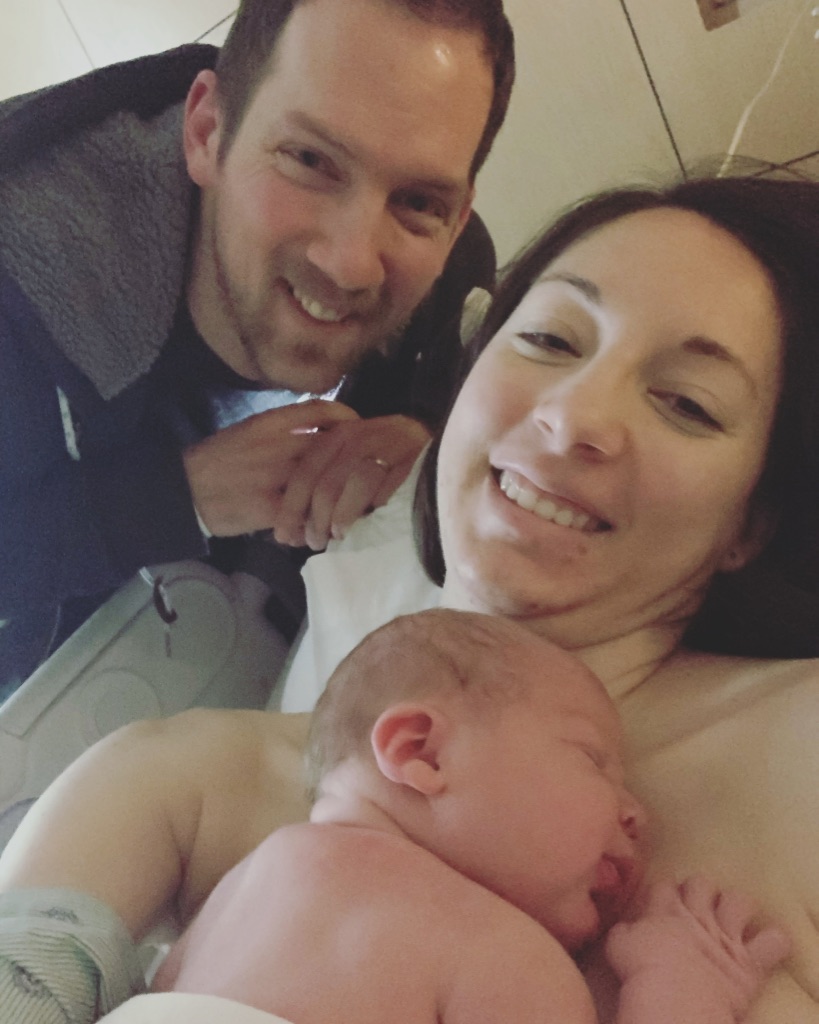
Allow me to share some photos. 🙂
Continue reading “Baby is here!”You might be wondering why I’m reviewing a non-piano-related book here on my blog. Bear with me – the reasons will become clear in a moment!

I remember hearing about this New York Times Bestseller when it came out in 2014. Although it sounded interesting to me at the time, I’m reading it for the first time recently. After finding out we were pregnant last summer and soon afterwards experiencing the woes of first trimester nausea and occasional midnight insomnia, I was suddenly on the hunt for an ebook I could read in bed on my phone without disturbing my sleeping husband. I liked the idea of reading something related to our new adventure as soon-to-be-parents, but was looking for something less information-driven than classics such as “What To Expect When You’re Expecting“. After seeing a recommendation for “Bringing Up Bébé” and reading its reviews on Amazon, I felt this book was just what I was looking for.
In this book, the author, journalist Pamela Druckerman, recounts her experience as an American raising a baby (and later, two more) in France. Soon after moving to Paris, she began noticing certain stark differences in child-rearing approaches in France compared to those typical in the United States. She started paying attention to this and asking questions — even stashing a notebook in her diaper bag — and investigating to see if she could learn more about how the French parent their children.
Druckerman noticed French children are generally well-behaved in public, waiting calmly for meals to arrive and waiting their turn to speak. French children enjoy a diversity of prepared vegetables, proteins, and salads and are accustomed to eating meals served in courses alongside their parents at designated times (8am, noon, 4pm snacktime, and 8pm), while American parents often expect their children might refuse to eat much else besides “kid food” (such as mac and cheese, chicken fingers, and snack food). French children are encouraged to be autonomous and independent in their play, being allowed more room to become absorbed and find pleasure in an activity for its own sake. In contrast, American parents might follow their children around the playground, delivering praise for mundanities such as going down the slide or tying their shoes. While French babies learn to “do their nights” around three months of age, American parents expect to function (or perhaps, not function) in a sleep-deprived manner for a year or more until baby begins to sleep through the night.
Continue reading “Book Review – Bringing Up Bébé: One American Mother Discovers the Wisdom of French Parenting” As shared in this post, my husband and I recently relocated from Bowling Green, Ohio to Saline, Michigan (outside Ann Arbor). I’m sure I’ll share a full tour of my new piano room, but for today, I wanted to share a simple solution I found to help remind my students to remove their shoes when they arrive.
As shared in this post, my husband and I recently relocated from Bowling Green, Ohio to Saline, Michigan (outside Ann Arbor). I’m sure I’ll share a full tour of my new piano room, but for today, I wanted to share a simple solution I found to help remind my students to remove their shoes when they arrive.
My new piano room is carpeted, and it’s a light color. I didn’t always enforce the “shoes off” rule in my previous home, but I decided I wanted to be more consistent about that here. Even I follow this rule strictly myself.
The main way to achieve that is to train students from the first time they are at the studio. However, I thought it might be nice to also add a friendly reminder for them to see when they arrive.
This is the entryway area to my studio. Continue reading “Inviting Piano Students to Remove Their Shoes”
I’ve been a bit slow with updates here the blog recently…and there’s been lots of big life changes over recent months! If you happen to follow me on Instagram or Facebook, you might have seen some of these updates. But for those of you who haven’t, here’s what’s new in my world…
My husband and I are expecting a baby! It won’t be long now before she’ll be making her debut. 🙂 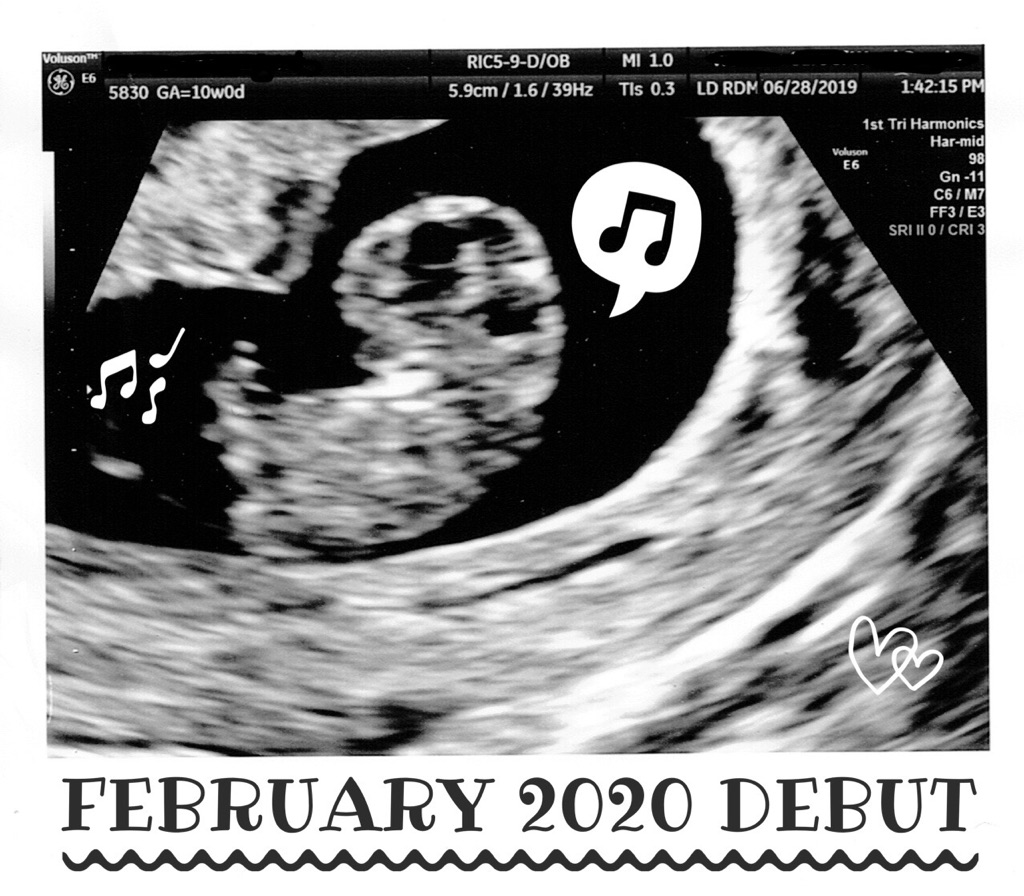
Knowing that Baby was on the way, my husband and I decided it was finally time to make work of relocating closer to family. We’ve been living in Ohio for about eight years now, ever since he began a Masters Degree program in English here. After graduation, my husband found employment in marketing and communications in Toledo, Ohio before landing a marketing position at University of Michigan in Ann Arbor, Michigan — an hour’s drive from home. We decided he’s been making the long daily commute long enough!
My husband’s family lives in the Ann Arbor area. Moving to Ann Arbor would also bring us a bit closer to my side of the family, on the other side of the state, in Grand Rapids, Michigan. Hopefully, this will be a longterm home for us!
So, we began house hunting.
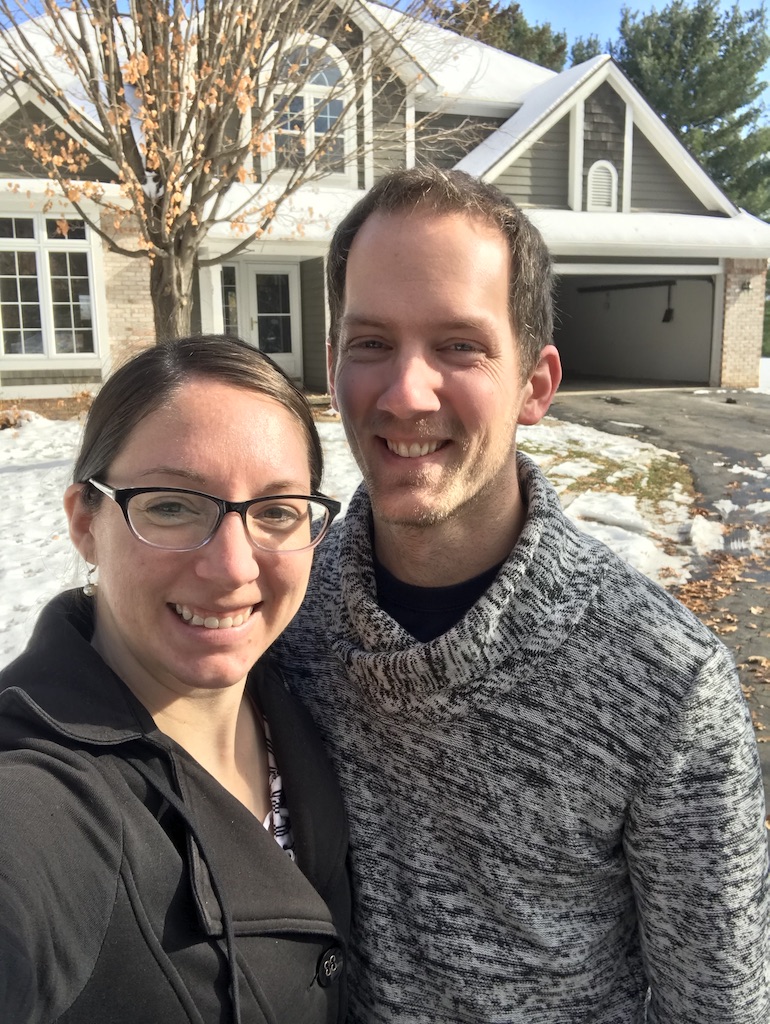
In November, we finally found the right house. It was important to us to find a suitable floor plan that would allow space for my piano studio operations to run smoothly while allowing living spaces for family life.
We are happy to be just outside Ann Arbor, in a super family-friendly town called Saline. I’m excited to enjoy the small town feel, while also benefitting from the amenities and events that an artsy town like Ann Arbor has to offer.

I decided I wanted to continue teaching my students in Ohio as usual through the end of the year. And so, we set our moving date as the Saturday before Christmas.
[Here’s a sneak peek at my new piano studio space!]

It’s official: we are Michiganders once again!
Yes, this means building my piano studio again in a new town. Yes, this means adjusting to motherhood and experiencing how that impacts my other roles. I’m sure I’ll be talking more about these topics here on the blog in upcoming months!
As for the present, we are excitedly awaiting Baby’s arrival. 🙂
Happy New Year to you, my dear readers!
Just a quick follow-up to the student Christmas gift post from some few weeks ago…
Here’s what I ended up gifting my students last month:

I ordered the black gloves from eBay (here). I used white 3D fabric paint to add the treble clef on the RH glove, and allowed it to dry. I came back later to flip it over and draw a bass clef on the LH glove. They turned out pretty cute!
I can’t take credit for the idea. I saw a piano teacher share the idea in one of the Facebook groups for piano teachers, quite some time ago. I saved the idea, thinking I’d probably use it some year. And here we are!
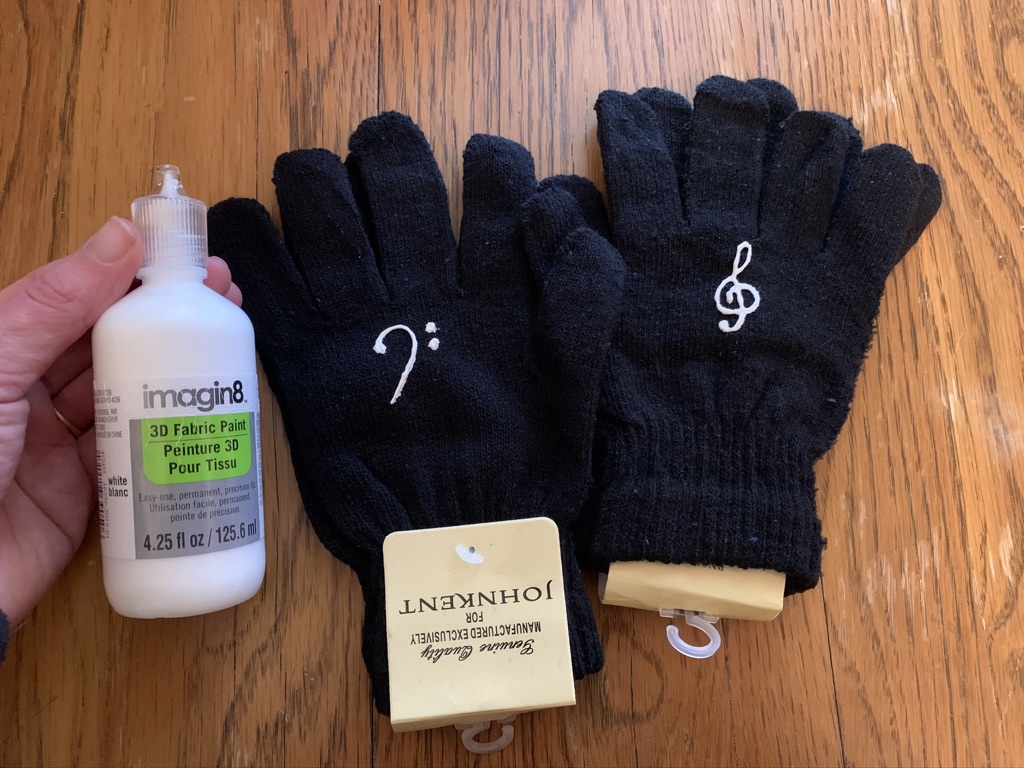
I baked the brownies myself and placed two pieces in each treat sack, separated by a square of parchment paper. A quick piece of ribbon makes them look a bit festive.

If you’re looking for a good brownie recipe, here’s the link to the one I used: Best Fudgiest Brownies. My husband is a better cook than I am; he’s able to bake them just right so they are wonderfully fudgey, plus achieve that lovely cracked look on the top. Fortunately, they still taste pretty great even when I bake them. 🙂
Just thought I’d share. I always appreciate getting ideas from other teachers, and bet you do too!
Happy Wednesday to you!
What do you do when a piano is too worn for use, but too costly to repair? Here are some ideas on how you can use an old piano.
Check out what how lovely this old bench looks with a fresh coat of paint! Continue reading “Ideas for Upcycling Old Pianos”

I know, I know…it’s barely November, and here I am already talking about Christmas gifts! But in my opinion, it’s never too early to start thinking ahead and brainstorming. I tend to enjoy the holidays more when I’ve managed to get an early start on my to-dos. 🙂
I don’t think it’s necessary to give your piano students gifts at Christmastime, but it’s a nice gesture if you feel so inspired!
And so, I thought it’d be fun to do a flashback post today, taking a look at the Christmas gifts I’ve done over the years for my students. Some of these gifts were pretty time intensive (certain years, apparently I was inspired enough to be willing to take on a big project!), and other years were simple, but thoughtful gifts. I hope perhaps these photos will give you a useful idea or two, if you’re looking for ideas for something to do for your own students!
Back in 2011, I created personalized glass sheet music ornaments for each student, with their name and the year written with a gold paint pen. They turned out so pretty! I love how they turned out, and would like to use this idea again in the future. Each student also received a chocolate Symphony bar. Read more here.
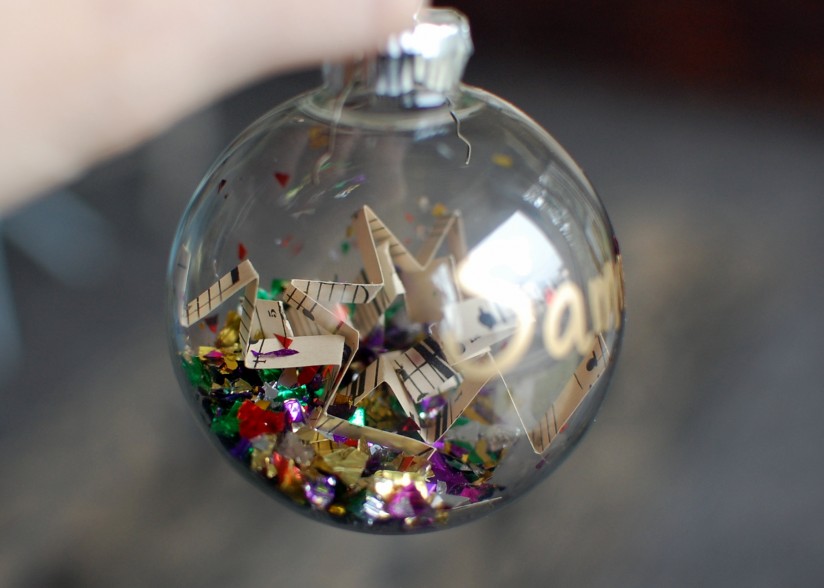
That year, I gave my adult students something else: a copy of the book “The A to Z of Foreign Musical Terms” by Christine Ammer. I learned about this book during grad school, when one of my professors recommended it as a music dictionary that actually contains all the words we commonly see in our music. (Have you ever looked up a word in your music dictinary, only to find it wasn’t included?!) This book is a nice slim volume, and a great price — I’d recommend it to any piano teacher or student! I use it not infrequently during lessons, to have students look up the terms in their pieces.

Yesterday, my student Robbie and I made a quick video for you, demonstrating how to play my new Trick-or-Treat! Rhythm Game.
Here’s what you’ll find in the video:
>>> Watch the video >>>
Below is more elaboration and tips on how to guide your students to perform rhythm patterns accurately. I hope you’ll enjoy hearing my thoughts on this, whether or not you plan to use my Trick-or-Treat! Rhythm Game!
Ask students: “Is this is duple meter or triple meter?” Sometimes I follow up with: “How do you know?”
With these rhythm cards, it’s easy: just look at the way the eighth note beams are grouped!
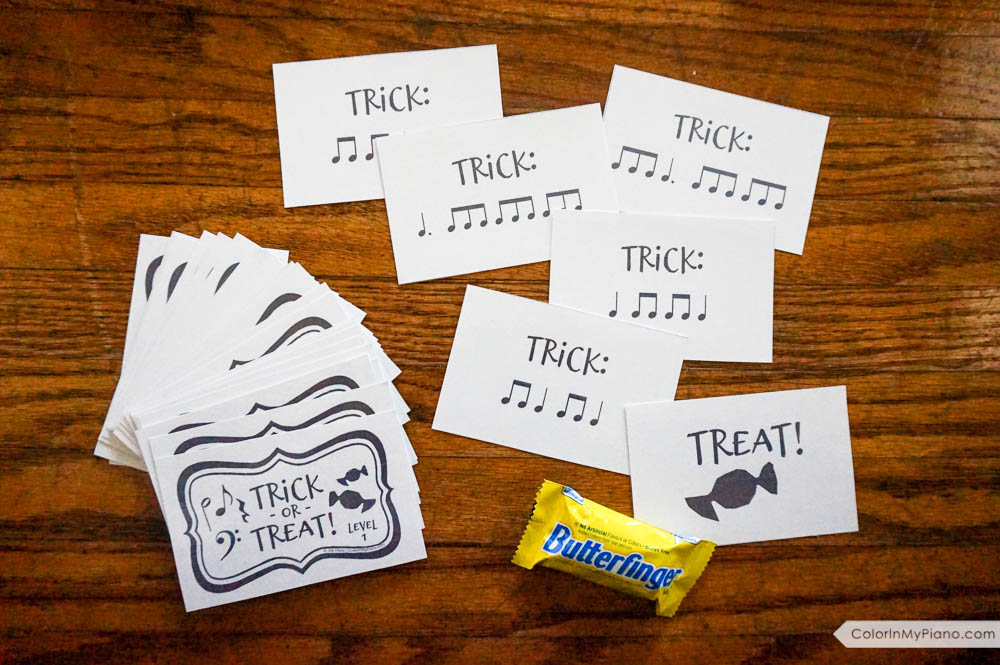
To make sure it’s not only a visual thing, though, I teach my students to listen to and feel the meter as well.
Continue reading “VIDEO: Playing the Trick-or-Treat! Rhythm Game with a Piano Student”I’m so excited to announce today a brand new printable game now available in my shop. This is the Trick-or-Treat! rhythm game!
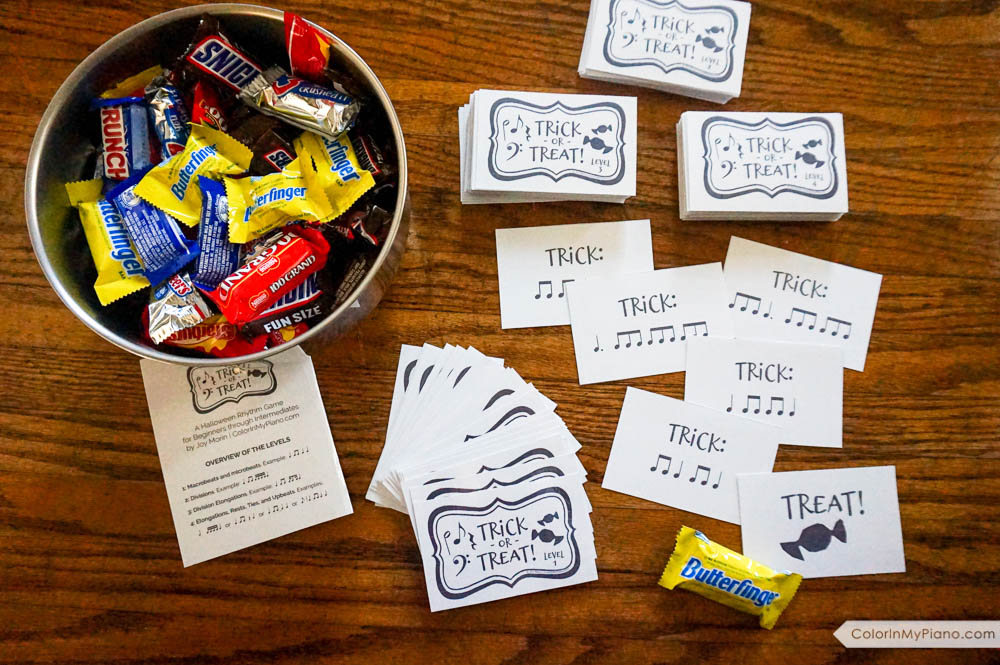
I first started testing this game around this time a year ago. My students were thrilled when I pulled it out again this year!

How does the game work?
This is a fun way to spend the first few minutes of your lessons around Halloween time, to improve your students’ rhythm skills. Playfully inform your student that you have a bowl of treats — but that they must EARN their treat by playing a rhythm game. 🙂

Choose the appropriate deck for your student (Levels 1-4). Explain to your student: There are TRICK cards and there are TREAT cards. When a TREAT card is drawn, the game is over and it’s time to choose a treat. When a TRICK card is drawn, the student performs the rhythm on the card and then draws again. To begin playing, fan out the cards for the student and ask them to randomly choose a card.
Continue reading “NEW in Shop: Trick-or-Treat! Rhythm Game”Do you have a chalkboard or whiteboard in your piano studio space?

I found this chalkboard at a thrift store a couple of years ago for something like $12. I’ve been experimenting with different things to put on it for my students, and thought I’d share a few ideas today!
I always put the studio name somewhere near the top. I’m no professional artist, but I like to experiment with different styles of lettering.

Remind your students of upcoming dates and deadlines. This can help parents and students stay in touch with what’s going on!

Your Cart is Empty